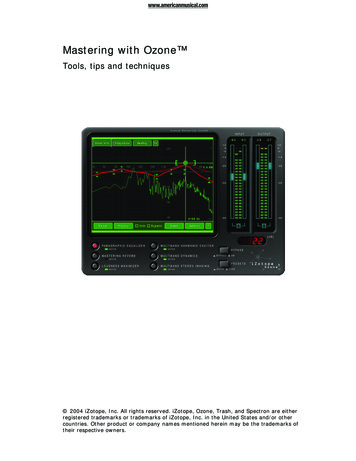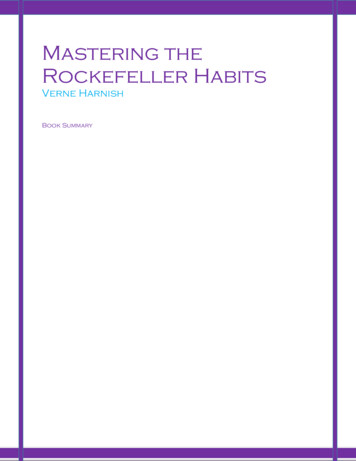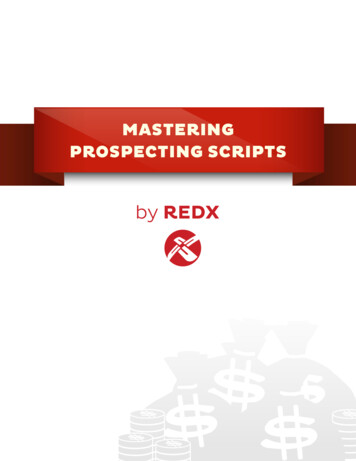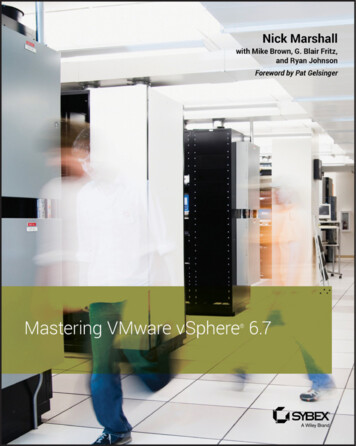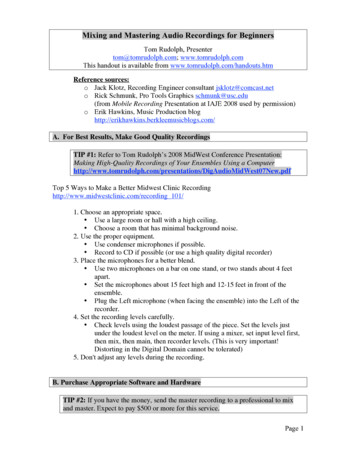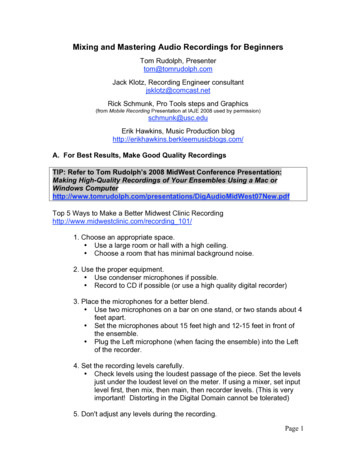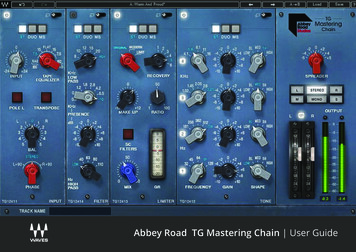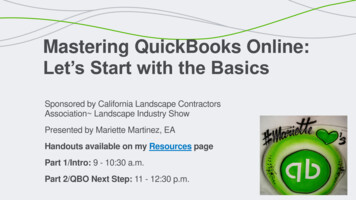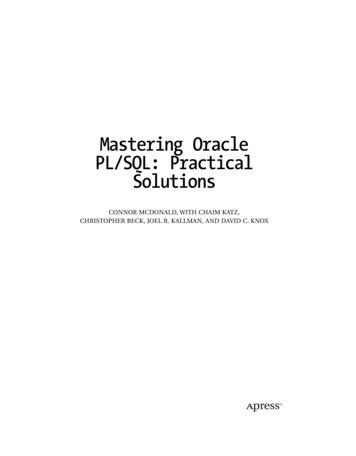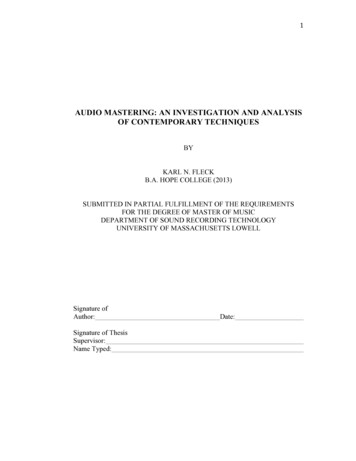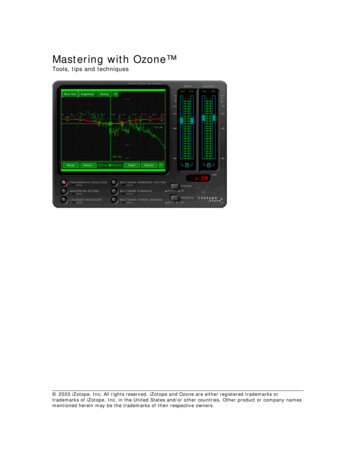
Transcription
Mastering with Ozone Tools, tips and techniques 2003 iZotope, Inc. All rights reserved. iZotope and Ozone are either registered trademarks ortrademarks of iZotope, Inc. in the United States and/or other countries. Other product or company namesmentioned herein may be the trademarks of their respective owners.
INTRODUCTION. 4What’s Wrong With My Song? . 4Intended Audience For This Guide . 4WHAT IS MASTERING? . 6The “Commercial Sound” . 6Consistency across the CD . 6Preparation for Duplication . 6WHAT IS OZONE? . 7A Mastering System . 764-bit Audio Processing . 7Analog Modeling . 7Digital Precision . 7Meters and DSP . 7UI Efficiency. 8GETTING SETUP FOR MASTERING . 9Software and Sound Card. 9Mastering Effects . 9Monitors . 10Headphones . 12SEVEN SUGGESTIONS WHILE MASTERING . 13EQ. 14What’s the Goal of EQ when Mastering? . 14EQ Principles . 14Using the Ozone Paragraphic Equalizer. 15EQ Shapes . 16EQ the Midrange . 19EQ the Bass . 20EQ the Highs . 21EQ’ing with Visual Feedback . 22Spectrum Options . 22Snapshots. 24Digital or Analog EQ . 24Matching EQ. 25General EQ Tips . 28MASTERING REVERB . 29What’s the Goal of Reverb when Mastering?. 29Reverb Principles . 29Using the Ozone Mastering Reverb . 29General Reverb Tips . 32MULTIBAND EFFECTS . 34Using Multiband Effects in Ozone. 34Setting Multiband Cutoffs . 35Crossover Options. 35Multiband Main Points . 36MULTIBAND HARMONIC EXCITER. 37Using the Multiband Harmonic Exciter in Ozone . 37General Exciter Tips . 38MULTIBAND STEREO IMAGING . 39Using Multiband Stereo Widening in Ozone . 40Phase Meter . 40Vectorscope . 41Multiband Stereo Delay. 42General Multiband Stereo Imaging Tips . 42MULTIBAND DYNAMICS . 44Compression Basics. 44Ozone Mastering GuidePage 2 of 66 2003 iZotope, Inc.
Dynamics Meters . 46Overall Compression Strategy. 49Bringing Limiting and Expansion into the Mix . 49Limiter . 50Compressor . 50Expander . 50Limiter/Compressor/Expander Summary . 51Multiband Dynamics . 51Bass Boost . 52Warmth . 53Vocal Treatment . 54Noise Gating . 54LOUDNESS MAXIMIZER . 56Loudness Maximizer Principle. 56Using the Ozone Loudness Maximizer. 57General Loudness Maximizer Tips . 59GENERAL OZONE TOOLS . 60Automation . 60History List . 61Setting the Order of the Mastering Modules . 62Preset Manager . 63Shortcut Keys and Mouse Wheel Support. 64SUMMARY. 66Ozone Mastering GuidePage 3 of 66 2003 iZotope, Inc.
INTRODUCTIONYou’ve just finished recording what you think is a pretty good song in your project studio. Theplaying is good, the recording is clean and the mix is decent. So you burn it to a CD andproudly pop it in your CD player. But when you hear it played after a “commercial” CD, yourealize that something is wrong.What’s Wrong With My Song? It’s not loud enough. It sounds wimpy next to other CDs. Turning it up or mixing downat a higher level doesn’t solve the problem. It sounds louder, but not, well LOUDER. It sounds dull. Other CDs have a sparkle that cuts through with excitement. You tryboosting the EQ at high frequencies, but now your song just sounds harsh and noisy. The instruments and vocals sound thin. Commercial songs have a fullness that youknow comes from some sort of compression. So you patch in a compressor and turnsome controls. Now the whole mix sounds squashed. The vocal might sound fuller, butthe cymbals have no dynamics. It’s full and lifeless. The bass doesn’t have punch. You boost it with some low end EQ, but that just soundslouder and muddier. Not punchier. You can hear all the instruments in your mix, and they all seem to have their own“place” in the stereo image, but the overall image sounds wrong. Your other CDs havewidth and image that you just can’t seem to get from panning the individual tracks. You had reverb on the individual tracks, but it just sounds like a bunch of instrumentsin a bunch of different spaces. Your other CDs have a sort of cohesive space thatbrings all the parts together. Not like rooms within a room, but a “sheen” that worksacross the entire mix.Don’t worry. It’s not that you’re doing anything wrong. There are just some things you stillneed to do to get that “sound”. You just need the right tools and an understanding of how touse them. You won’t become Bob Ludwig1 overnight (or probably ever) but you can makedramatic improvements in your master recordings with a little work.We put this document together to help others in their quest for better sounding masters. Wedon’t claim to be mastering masters. If we could master the next Christina Aguilera hit wouldwe be writing code and manuals or sitting in a mastering studio with Christina Aguilera?What we can give you is professional quality mastering software (iZotope Ozone ) andguidance on how to use it. But in the end there are no right answers, no wrong answers, andno rules. At least if there are, we still haven’t found them. So in the end just experiment andhave fun.Intended Audience For This Guide If you don’t know anything about mastering and don’t have Ozone, we stillhope this guide will help you. Sure, we think you should use Ozone. But welearned a lot about mastering from “the online audio community” and we1http://www.gatewaymastering.com/ Bob Ludwig has won the TEC award for mastering every year he’sbeen eligible. That pretty much sums it up.Ozone Mastering GuidePage 4 of 66 2003 iZotope, Inc.
want to give something back in return (in addition to iZotope Vinyl2). Thisguide can be freely copied or distributed for noncommercial purposes for thatreason. If you don’t understand mastering but do have Ozone, you’re in luck. Ozonegives you the tool to get “that sound” and this guide shows you how to do it. If you have Ozone and know the basics of mastering, this guide will still showyou tricks or techniques that are possible in Ozone. Just say “yeah, I knewthat” when appropriate for the other dx.html Analog modeling plug-in for lo-fi destruction. Thatpretty much sums that up.Ozone Mastering GuidePage 5 of 66 2003 iZotope, Inc.
WHAT IS MASTERING?Although there are many definitions of what “mastering” is, for the purpose of this guide werefer to “mastering” as the process of taking a mix and preparing it for manufacturing. Ingeneral, this involves the following steps and goals.The “Commercial Sound”The goal of this step is to take a good mix (usually in the form of a stereo file) and put thefinal touches on it. This can involve adjusting levels and in general “sweetening” the mix.Think of it as the final coat of polish, or the difference between a good sounding mix and aprofessional sounding master. This process can involve adding broad equalization, multibandcompression, harmonic excitation, loudness maximization, etc. This process is often actuallyreferred to as “premastering” but we’re going to refer to it as mastering for simplicity. Ozonewas created to specifically address this step of the process: to put that final professional or“commercial” sound on a project that’s been mixe
provide a complete system for mastering (or technically “pre-mastering” as it addresses the processing but not the CD layout, file conversion, etc.) In addition to providing audio processing, it provides meters, tools for taking snapshots of mixes, comparing settings, and rearranging the order of the mastering modules within the system.
